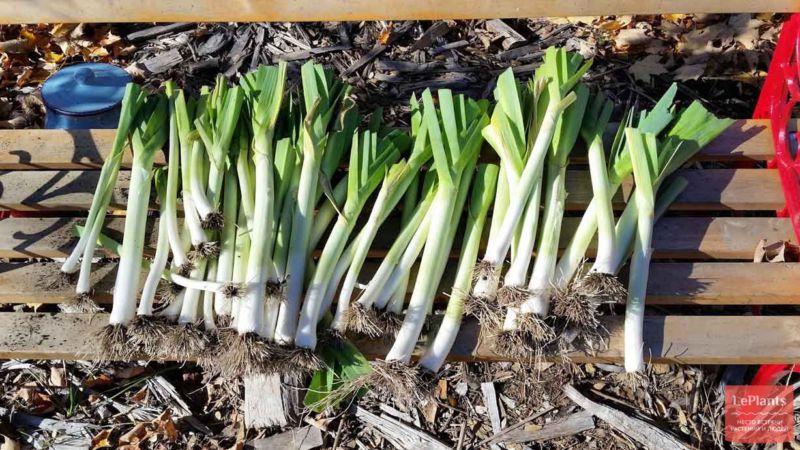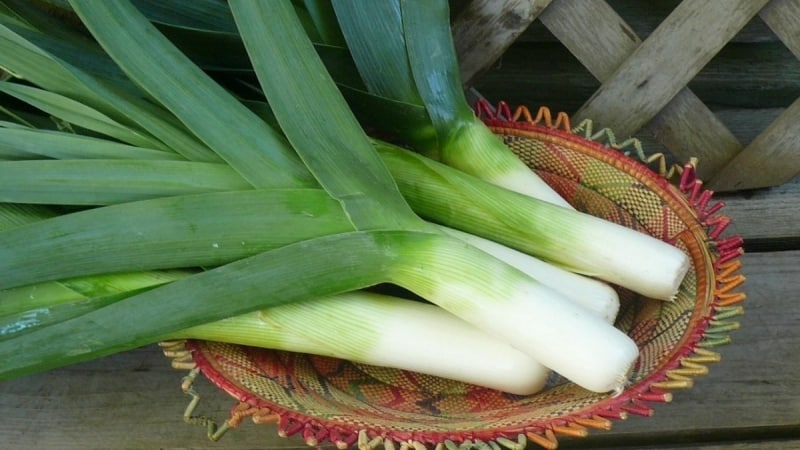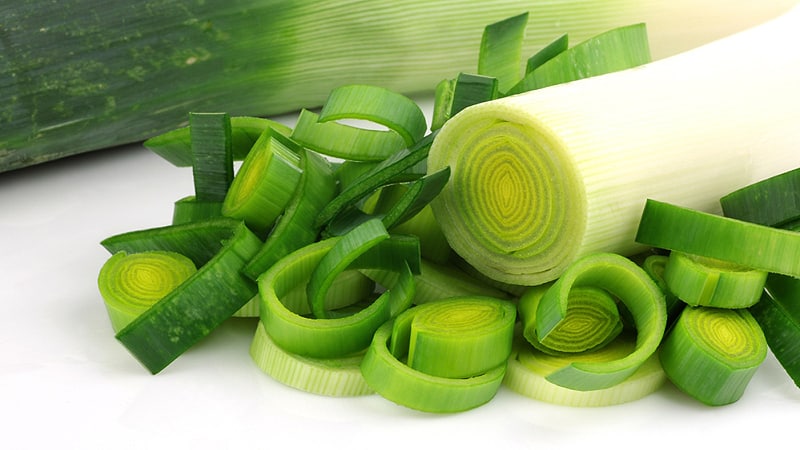How to properly store leeks after harvesting
Leek valued in cooking and folk medicine for its mildly spicy, piquant taste and rich chemical composition. It contains B vitamins, carotene, potassium, calcium, phosphorus, magnesium. It does not lose its beneficial qualities for a long time, and during storage the amount of ascorbic acid in the white part increases by more than 1.5 times. This article will tell you how to prepare and store leeks.
How to store leeks after harvesting

Vegetables are harvested already in August, but at this time they ripen completely and are used either for food or for short-term storage.
To preserve leeks until May, they are harvested before the first heavy frost: in October-November. It is then that the onion ripens completely and becomes resistant to various damages.
Rules
Basic recommendations for storing leeks throughout the season:
- Immediately after digging, the vegetable is dried in a well-ventilated area.
- Remove damaged, dry and yellow leaves.
- Get rid of broken, rotten, damaged plants.
- If signs of disease appear on the onions during drying, such specimens are immediately removed so as not to infect others.
- In its unprocessed form, the vegetable is stored only in a vertical position, having previously been cut off on both sides. The stems are removed by 2/3, the roots by half.
Optimal conditions
Suitable premises for storing leeks: refrigerator, cellar or basement, balcony, pantry.Temperature and humidity should be constant (+0...+4°C, 40–50%), and the room itself should be well ventilated and dry.
Important! The storage area is ventilated at least 2 times a month. This prevents air stagnation, removes unpleasant odors and destroys germs.
Selection and preparation of onions for long-term storage
The vegetable tolerates cold temperatures down to -7°C, but it is better to harvest before the first frost. Only healthy specimens that have not been subject to disease or pest attacks are suitable for storage.
Thick parchment paper keeps onion feathers fresh. Newspaper is not suitable for this purpose, as the product will absorb printing ink.
The nuances of storing substandard products
Non-standard leeks are stored only frozen, dried or pickled. Under room conditions, such onions in an unprocessed state dry out and become unsuitable for consumption after 2 days.
Storage Features:
- the lower part of the vegetable is cut off by 1.5–2 cm;
- a small amount of the harvest is kept in the refrigerator, compartment for greens and vegetables, 1–1.5 weeks;
- to preserve the juiciness of the product, it is sprinkled with coarse salt;
- leek is well preserved in a closed glass container with the addition of sunflower oil or salt water;
- vegetables showing any signs of wilting or spoilage are thrown away.
Onions are kept at a temperature not lower than -5°C. At lower values, it freezes slightly and loses its elasticity and taste.
Important! When preparing vegetables, remove all contaminants without water, since excess moisture shortens the shelf life of the product.
Fresh storage methods

Onions are kept in a cool place (refrigerator, basement, balcony) depending on the form in which the vegetable will be consumed.
In a refrigerator
Housewives often choose this option for storing onions at home. The greatest attention is paid to plant preparation:
- Whole specimens without damage are selected from the entire harvest.
- They are thoroughly cleaned of debris and dirt.
- Remove dead and yellow leaves and blackened parts of the bulbs.
- Allow the vegetables to dry.
- Place in plastic bags with small holes.
- Keep the preparation in the department for greens and vegetables.
On the balcony
To store leeks, the balcony must be closed and moderately insulated so that the temperature does not drop below 0°C:
- Sand is poured into wooden boxes to a depth of 3–5 cm.
- Place vegetables in one layer.
- Cover the top with parchment or other thick paper.
- They are insulated with a light blanket or fabric to protect the crop from unexpected severe frosts.
In the cellar or basement
It is important to choose the right container here. The best option is a wooden box measuring 1x1 m, which is pre-dried. Disinfected sand protects vegetables from changes in humidity and temperature:
- The bottom of the container is covered with sand to a depth of 5–7 cm.
- The leeks are placed in one layer.
- To protect from dirt and dust, cover everything with parchment.
- Place the workpiece in the basement.
Only fresh plants of the same variety are kept in the box.
other methods
To extend the shelf life of leeks, housewives freeze them, marinate or dried.
Pickling
A slight heat treatment removes the bitterness from the vegetable, but retains the taste and vitamins.
Ingredients for the classic recipe:
- leek - 5 pcs.;
- sugar - 50 g;
- rock salt - 15 g;
- vinegar 6% - 3 tbsp. l.;
- water - 0.5 l;
- bay leaf - 3-4 pcs.;
- vegetable oil - 50 ml;
- black peppercorns - 5-6 pcs.
Procedure:
- The onions are cleaned of dirt, the green part and roots are cut off.
- Each plant is cut crosswise into 2-3 parts.
- Place vertically in clean glass jars.
- Boil water, add sugar, salt, bay leaves and pepper. Let it simmer for 5 minutes, then add vinegar.
- Keep on the fire for another 3 minutes, pour the hot marinade over the vegetables.
- Add vegetable oil to each jar, close with screw caps, and turn over.
- When the workpiece has cooled, it is placed in the basement, refrigerator or on the balcony.
Freezing
Leeks in this form do not lose their taste and density. Vegetables are first cleaned of contaminants and dried. Grind in any convenient way, place in a bag or plastic containers and send to the freezer.
Advice! Onion freeze and whole, pre-wrapped in parchment paper.
Drying
Freshly harvested crops are dried in the open air:
- Remove dying or damaged parts of plants.
- Vegetables are finely chopped.
- Spread onto parchment in one thin layer.
- Dry in a ventilated place or in a dark, warm room.
In an electric dryer or oven, the leek will be ready in 1-2 hours at a temperature no higher than +100...+120°C.
Terms and conditions of storage
In its natural form, onions remain fresh for 3-4 weeks, when using auxiliary means (sawdust, sand, paper) - 2-4 months.
In indoor conditions, the plant does not deteriorate for up to 2 weeks.
Optimal conditions:
- lack of direct sunlight, heat;
- air humidity within 40–50%;
- place storage dry and cool (temperature - +2...+6°C);
- regular supply of fresh air.
Frozen onions can be stored for a year. The product should not be allowed to thaw and re-freeze, otherwise the taste and consistency will be affected.
Pickled or canned leeks are consumed throughout the year. The structure, taste and aroma of the product do not deteriorate.
Dried onions are kept for up to 1 year in a closed glass or plastic container at room temperature.
Adviсe

Even under the most suitable storage conditions, leeks dry out over the entire season. Therefore, only large, healthy specimens of the same size are left for the winter. Medium and small ones are frozen or dried.
Clods of earth are removed from the roots by hand. Do not shake the onion, otherwise the stem will be damaged, which will make the plant unsuitable for long-term storage.
The room in which the crop is kept is regularly ventilated. Ventilation holes are made in the bags.
Conclusion
Leek improves appetite, removes excess fluid from the body, strengthens the immune system, and is useful for urolithiasis and gout. It is eaten pickled, baked and fresh. If optimal conditions are met, the harvest will last until the next season. The main thing is to prepare a cool, dry place and remove diseased or damaged plants in a timely manner.